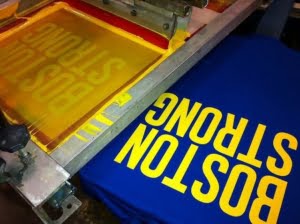In your shop, right now, you have established processes for everything you do.
Some are working fantastic. Others are working ok. Some probably aren’t working as they should. And lastly, there are some things that exist but don’t have a process at all.
What processes am I talking about? Namely these:
- Lead Generation and Marketing Processes
- Quoting Processes
- Sales Processes
- Order Entry Processes
- Purchasing Processes
- Receiving Processes
- Scheduling Processes
- Art Creation and Approval Processes
- Embroidery Digitizing Processes
- Screen Making Processes
- Digital Printing Color Matching Processes
- Production Organization Processes
- Screenprint Production Processes
- Embroidery Production Processes
- DTG Production Processes
- Heat Press Production Processes
- Dye Sublimation Production Processes
- Post Production Processes (Hangtagging, Polybagging, etc.)
- Order Packaging Processes
- Shipping Processes
- Invoicing Processes
- Customer Follow Up Processes
- Referral Collection Processes
- Accounting Processes
- Hiring Processes
- Training Processes
- Employee Review Processes
Whew!
That’s a lot of processes. You may have more. But here’s the thing. Within each of these, there are subprocesses too.
Or not. Maybe you haven’t defined anything. It could be that your lack of processes means your employees make up the rules on how to do the work.
Yikes!
Take a Step Back
Today, I want you to take a step back and think about all of the processes that you deploy in your business.
Are they working as they should?
Let’s take the “Quoting Process” for example. How many people are actively quoting customers in your shop? There probably is a system, maybe some software, that is being used to construct a quote when a customer requests some pricing.
Is everyone quoting it the same way?
How do you know?
Take This Test
Without any warning or hint of what you are doing, ask each person on your quoting team to price out the following potential order and email you the quote. They are not allowed to compare notes or talk to each other. For the test to work, each person needs to do the work independently of everyone else.
- Quantity: 25 S / 25 M / 25 L / 25 XL / 25 XXL / 10 XXXL / 10 XXXXL / 5 XXXXXL
- Youth Quantity: 25 XS / 25 M / 25 XL
- Island Yellow Jerzees 29M & 29B 50/50 T-shirt
- Customer provided art
- Front Left Chest – PMS 2995 & PMS 186
- Full Back – PMS 2995, PMS 186, & Black
- Event
- In-hands is five business days from today
- Shipping to some city in your state. Pick one.
Get everyone in your team to quote it.
Including the owners of the company if they quote. Why? Because typically they don’t follow the processes well when quoting. (Sorry if this is you)
What Are We Doing Here?
This is testing to see if the process is working as it should. By now, you’ve mapped out how to quote an order for a customer. You’ve trained your staff.
Here are some things that might have been missed:
- Did they notice that the PMS 2995 Light Blue needs an underbase to work on the Island Yellow Shirt?
- Adult and Youth Shirts. Did you quote two sets of screens?
- Youth and up to an XXXXXL shirt. That’s a big size spread. Did everyone price that correctly?
- In-hands five business days from today in another city.
- When should this order ship? Should it be a rush? Is there a fee?
- What’s the availability of the garments with the distributor you use? Did they check?
- When should the garments be in your shop, and do you need to overnight them in to produce the order and hit the event date?
If you get a pile of different answers, this may mean that your customers are getting these different answers too.
What do you think this might mean to your bottom line every year?
Observation
In any department, you can learn a lot simply by observing the work being performed. Watch how your staff works. What stresses the process?
Another point that you should consider is that your crew may be working hard implementing and diligently performing a process that simply doesn’t work the way it should.
For example, once I was in a shop doing some coaching work and the management team spent a good deal of time organizing the jobs for production.
That’s great.
Except for them, their process was to line the boxed inventory in lanes on the floor of the shop by the day of the week that the orders are going to be run. Monday. Tuesday. Wednesday. Thursday. Friday.
Here was their problem.
They spent a considerable amount of time moving boxes from one day to another because the art wasn’t approved in time. Or, they were missing a few pieces for the order and the goods weren’t coming in until a day or two from now. Not to mention, it was hard to conceive how to stage larger, palletized orders. Plus, they had to sort and find the inventory from another location for jobs that had inventory come in but weren’t scheduled to be worked on for a week or two.
They had a process. But it didn’t work well.
One of their staff members spent virtually the entire day moving boxes around on the floor to keep up with matching them up to what day the jobs were going to be produced.
It was the equivalent of a t-shirt box Whack-A-Mole.
That was a lot of wasted effort and labor. To them, they were working very hard at the organization. Of course, they wanted to feed their production machines work, and this was the system they devised for staging.
The New Way
During my onsite visit, I suggested an alternative idea.
What if all of the inventory was staged in one area after it was received? Each box was already labeled with the order number and other information. Simply segregate the boxes by the last digit of the work order number.
The boxes that end with a three, are in row three. Boxes that end with a seven, are in row seven. You get the picture.
Palletized orders are staged the same way but in a different area. Orders that had four boxes or less were in one area. The orders that had five boxes or more were on skids. Why? You can move four boxes in one trip with a handcart or dolly.
When the staging team wants to bring the inventory to the production team, they simply look at the last digit of the work order and walk over and retrieve the goods. Inventory boxes are never moved from one row to another. After they were received and placed in the rows, the inventory sat until it was needed.
They could redeploy the person that was moving the inventory boxes from Tuesday to Thursday every day to other, more important tasks.
Think Downstream
In another shop, I was brought in to look at their production efficiency.
I was standing there talking to the owner when I noticed a woman absolutely slaying it on the neck printing machine. For this shop, they create custom printed apparel that does direct to retail stores. Every shirt requires a custom neck label.
The owner was explaining to how proud he was of this particular staff member, as she was a magician on this neck label press.
As I observed, I noticed that she printed and then pulled off each shirt and tossed it into a large box. When the box was full, it was brought down to a table, turned over, and then all of the shirts were segregated out by size and folded.
She was so fast printing it took three other staff members to fold the shirts! They had a hard time keeping up, in fact.
But with that, I saw an opportunity for improvement.
Why not have someone else pull off the shirt and fold it on a cart? The owner said that the printer was so quick, nobody could keep up.
“Hmm”, I thought. “Let’s test that notion.”
We brought a staging cart over and placed it on the opposite side of the neck tag printer. One of the sorter crew came over too, and we had them pull a shirt off and fold it onto the cart.
She easily could keep up. And in fact, they could actually run that machine faster as the printer didn’t have to slow down to remove the printed shirt.
The owner was shocked. “I can’t believe we didn’t think of that”, he said. This meant that two other workers could be retasked to work on other priority jobs.
The Lesson Here
It’s great to have processes. I love them.
Not so great to have processes that don’t adequately work or cause problems down the road.
In your shop, are you working really hard on the wrong things?
What can you improve or tweak?
Have you ever asked your employees their opinion on the work they are doing every day? Do yourself a favor, ask this question to each team member individually, without other people listening:
“If you had a magic wish to change one thing that could make your job easier to perform, what would you want to change?”
Here’s a secret. If you ask thirty different people, you might get thirty different answers. But, you could also get many that express the same idea.
This simple “One Wish” question can become a great tool to examine your processes and suggest a new direction for your company. The reason you need to keep the conversations private is to avoid group-think. You don’t want, “Yeah, what she said” as someone’s answer.
Get to your one source of truth.
But here’s my question for you. Are you willing to change when you get these new ideas?
That’s the scarier part.
“Learning is the beginning of wealth. Learning is the beginning of health. Learning is the beginning of spirituality. Searching and learning is where the miracle process all begins.” – Jim Rohn
“Good thinkers always prime the pump of ideas. They always look for things to get the thinking process started, because what you put in always impacts what comes out.” – John C. Maxwell
“One of the great paradoxes of leadership is a leader’s need to be both stubborn and open-minded. A leader must insist on sticking to the vision and stay the course to the destination. But he must be open-minded during the process.” – Simon Sinek
Screenprint Efficiency And Downtime
Are you happy with your screenprinting production efficiency? Getting everything out daily? Missing deadlines?
Recently I wrote about how Production Downtime is cancer that you need to control in your shop. Regardless of how successful your shop runs, this challenge costs you daily due to lost opportunity to print more shirts.
Read this article – Stop Throwing Away Money.
If you want to take charge and control this problem, I have a new online course – “6 Steps to Kill Your Production Downtime”.
This is the absolute easiest way to build better controls and processes in place to handle this expensive problem for your shop. I walk you through everything with simple, easy to understand lessons.
It is $997, which for most shops is less than what this problem costs you daily in lost revenue due to excessive production downtime.





